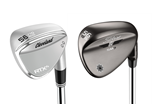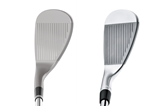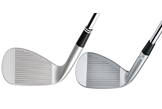TWIN TEST: Cleveland RTX 4 v Titleist Vokey SM7 wedges
Published: Last updated:
Twin Test: Cleveland RTX 4 v Titleist Vokey SM7
Ever since Titleist introduced Vokey wedges back in 1997, there’s been debate among serious golfers about whether they, or Cleveland, make the best scoring clubs.
Cleveland is famous for its wedges – they’ve been creating them for many of the world’s best players since 1979 – but the all-new RTX 4 is said to be the most tour-authentic wedge they have ever made.
TESTED: Titleist Pro V1 vs Mail Order golf balls
With both brands having new models for 2018 (the SM7s hit the market in March) we thought it was a good time to put the pair in a head-to-head test to see if we can settle the argument once and for all, and help you make a better buying decision in the process.
| Cleveland RTX 4 | Titleist Vokey SM7 | |
| Website | www.clevelandgolf.co.uk | www.titleist.co.uk |
| Price | £129 | £150 |
| Lofts | 46-64° (18 options) | 46-62° (23 options) |
| Head Options | Four sole grinds (Full, Mid, Low, XLow) |
Six sole grind options (F Grind, S Grind, M Grind, D Grind, K Grind, L Grind) |
| Finish Options | Tour Satin, Black Satin, Tour Raw |
Tour Chrome, Brushed steel, Jet Black |
| Shaft | Dynamic Gold Tour Issue S400 |
Dynamic Gold S200 |
YOU NEED TO KNOW
Cleveland RTX 4
RTX 4 is unashamedly designed for decent players, and Cleveland can do that because they also produce a cavity back wedge (the CBX), which is more suited to golfers who use cavity back irons. RTX 4 is Cleveland’s most tour- authentic wedge yet, with less off set and a deliberately tour-driven shaping. Cleveland obsess over every last detail so RTX 4 has a fourth-generation Rotex face to maximise spin, a more centred CG location (thanks to Feel Balancing Technology) and a tour-endorsed shaft and grip.
More Cleveland RTX 4 wedge information here
TESTED: Do rusty wedges really spin more?
Titleist Vokey SM7
SM7s have a progressive vertical centre of gravity (where Cleveland focus on centring CG horizontally across the face) as they say when loft increases, golfers tend to hit shots higher on the face. Lower lofts have narrower, deeper grooves whereas higher lofts are wider to maximise spin and control. Every groove is inspected, which Vokey reckons along with a parallel face texture (between each groove) and tighter tolerances gives 100rpm more spin. Like the RTX 4, the SM7s are cast heads, not forged.
More Titleist Vokey SM7 wedge information here

LOOKS
Cleveland RTX 4: 8/10
Appearance is utterly subjective, so we completely understand what we think is a great shape will be someone else’s ugly stick. In our opinion, RTX 4 is a brilliantly refined shape; both testers liked the lack of off set on the 52° loft, which is different to RTX 3. Both also felt the 52° head shape was slightly more pleasing, mainly because the leading edge gets more rounded as loft increases on the 58°. Cleveland say this is driven from tour feedback.
Titleist Vokey SM7: 9/10
Wedges are really personal bits of kit. It’s worth taking time to find the model which fills you full of confidence at address. We traced the profile of the wedges, to see how much difference there really is in shape and it boils down to nothing more than a pencil lead’s width, yet there’s a difference at address. We reckon the SM7s just about have the edge because the flow of off set and leading edge shaping between lofts is a bit more natural.
REVIEW: Cleveland CBX cavity back wedge
SPIN, FEEDBACK AND FEEL
Cleveland RTX 4: 9/10
Cleveland put some serious time and effort into perfecting how their wedges spin, and our results suggest it has paid dividends. Their designers have so much wedge know-how they reckon face grooves are almost back to generating the same levels of backspin from the rough as before the 2012 groove rule change. Every full shot hit by Simon had over 8,000rpm of backspin, yet his custom-fitted Vokey didn’t produce a single shot over 8k.
Titleist Vokey SM7: 8/10
Titleist insist we’re fitted before testing. Simon’s wedges were fitted with a shaft matched to his preferred iron model (True Temper XP-95) which could have impacted spin performance; Ben used the stock S200. Both testers struggled to match the RTX 4 for backspin (averaging 500-1500rpm less). You shouldn’t make a decision based on our spin numbers alone, but where feel and feedback were first class with the Vokey, as you’d expect, we reckon it’s worth paying close attention to spin if you end up looking at custom shafts to match your irons.
TESTED: Forged irons ranked by forgiveness
TECH
Cleveland RTX 4: 10/10
Somehow Cleveland keep pushing the wedge tech bar higher. We love how removing weight from the hosel edges the centre of gravity towards the middle of the face. It’s still 2mm towards the heel, but Cleveland say other brands can be between 5-10mm towards the heel side, which means if you hit the centre of the face you don’t get the best performance. Every groove is protected from the nishing process and the face milling is centred, deep and aggressive – serious attention to detail.
Titleist Vokey SM7: 9/10
Make no mistake, there’s plenty of tech in the SM7s. Bob Vokey has worked with countless tour players over the years to perfect his clubs. The milled face, milled grooves, parallel face texture between the grooves (to improve traction between club and ball) and progressive centre of gravity (moves the CG up to 2mm) are all great, but we reckon Cleveland just about edge the tech battle as they also protect every groove during the nishing process.

OPTIONS
Cleveland RTX 4: 9/10
On paper the RTX 4 has fewer options when it comes to loft and sole grind combinations. But the four versions keep things reasonably simple, so there’s a decent chance you’ll be able to decide which is best for your game. Cleveland’s trump card, though, is saying golfers who use cavity back irons should use cavity back wedges. It’s why they have the brilliant CBX (adding another eight options), which Titleist can’t quite match.
Titleist Vokey SM7: 9/10
Titleist say that thanks to six sole grinds they can fit all skill levels of golfer to an SM7, so there’s no need to offer a cavity back model. It’s a solid argument, yet we can’t help thinking compact blade style wedges might not be the best fit for all club golfers out there. Titleist’s claim of “offering the game’s most complete selection of lofts, bounces and grinds” is inescapable and mightily impressive when backed up by a huge selection of custom shaft and grip options, too.
VERDICT
Cleveland RTX 4: 36/40
We didn’t consider cost during our analysis. But, three RTX 4s will set you back £63 less than the SM7s, and the Dynamic Gold Tour Issue shaft (which has tighter tolerances) is more expensive to buy. Others might rank head shapes higher, feel tech’s a dead heat or reckon we should have added extra marks for the SM7’s tour usage. But the fact we kept coming back to was that RTX 4 delivered more spin for full and half shots with 52° and 58° lofts for both testers – that speaks volumes about its performance.
Titleist Vokey SM7: 35/40
If you have the ability to have the choice between SM7 and RTX 4s you really can’t make a bad decision. You won’t miss out whichever way you turn. Vokey wedges, like Scotty putters, are seen by many as the pinnacle, and Titleist never shy away from telling you “we’re No.1 on Tour”. With so many options make sure you get a proper fitting.



